
(a)
Interpretation:
The validation corresponding to the fact that aspartame is chiral is to be stated. If aspartame is chiral, then the possible number of stereoisomers for aspartame is to be stated.
Concept Introduction:
A compound that contains a chiral carbon is known as chiral compound. Carbon atom that contains all the four different atoms or group of atoms attached to it is referred as the chiral atom. This carbon is also known as stereocenter.
The possible number of stereoisomers is calculated by the expression
Answer to Problem 10P
Aspartame is a chiral compound. The possible number of stereoisomers for aspartame is
Explanation of Solution
The aspartame is a chiral compound. The structure of aspartame which contains chiral carbon atoms is shown as,
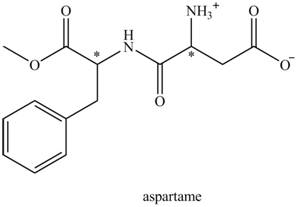
There are two chiral carbon atoms present in aspartame which are marked with asterisk sign. In the structure of aspartame, one carbon atom is directly bonded to
Thus, the possible number of stereoisomers in aspartame is,
Where,
- is the number of stereocenter.
Thus, the possible stereoisomers of aspartame is
(b)
Interpretation:
The name of each functional group present in aspartame is to be stated.
Concept Introduction:
An atom or a group of atoms that shows characteristic physical and chemical properties are collectively known as
Answer to Problem 10P
The name of each functional group present in aspartame is ester group
Explanation of Solution
According to the structure of aspartame shown in Figure 1, there are four functional groups present in the structure of aspartame.
The name of all the functional group of aspartame is ester group
(c)
Interpretation:
The net charge on aspartame molecule in an aqueous solution at
Concept Introduction:
The negative logarithm of hydrogen ion concentration of the solution is known as
Answer to Problem 10P
The net charge on aspartame molecule in an aqueous solution at
Explanation of Solution
In an aqueous solution of
Hence, there is no change of charge takes place in aspartame and it possesses zero net charge.
(d)
Interpretation:
The validation corresponding to the fact that aspartame is whether soluble in water or not is to be stated.
Concept Introduction:
According to the concept of solubility, it is mentioned that like dissolves like. Generally, polar compound can only be dissolved in polar solvents and non-polar or weakly polar compounds can only be dissolved in non-polar solvents or weakly polar solvents.
Answer to Problem 10P
Aspartame is soluble in water.
Explanation of Solution
The given structure of asparatame is present in zwitterion form which suggests that it is a polar molecule. According to the concept of like dissolves like, aspartame is soluble in water because water is also a polar molecule.
(e)
Interpretation:
The structural formulas for the products that are obtained by the complete hydrolysis of aspartame in aqueous
Concept Introduction:
An atom or a group of atoms that shows characteristic physical and chemical properties are collectively known as functional groups. The functional group is the most reactive part present in the molecule. The main functional groups are
The addition of water molecule to the compound is known as hydrolysis that compound.
Answer to Problem 10P
The structural formulas for the products that are obtained by the complete hydrolysis of aspartame in aqueous
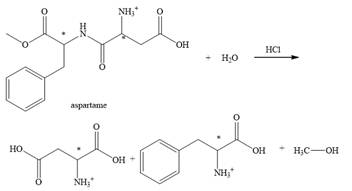
Explanation of Solution
The hydrolysis of aspartame in the presence of aqueous
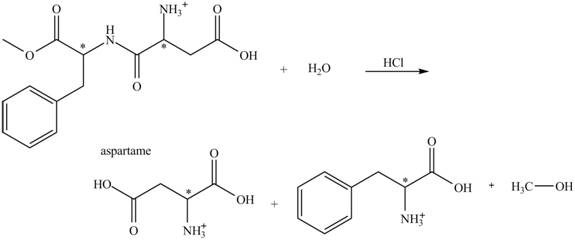
Figure 2.
The reaction of aspartame with aqueous
(f)
Interpretation:
The structural formulas for the products that are obtained by the complete hydrolysis of aspartame in aqueous
Concept Introduction:
An atom or a group of atoms that shows characteristic physical and chemical properties are collectively known as functional groups. The functional group is the most reactive part present in the molecule. The main functional groups are
The addition of water molecule to the compound is known as hydrolysis that compound.
Answer to Problem 10P
The structural formulas for the products that are obtained by the complete hydrolysis of aspartame in aqueous
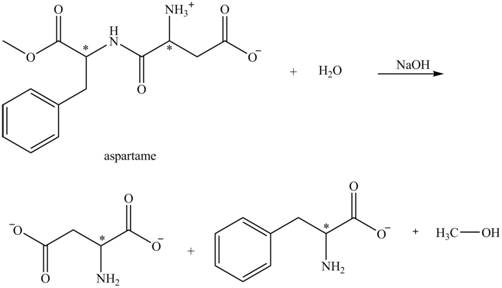
Explanation of Solution
The hydrolysis of aspartame in the presence of aqueous
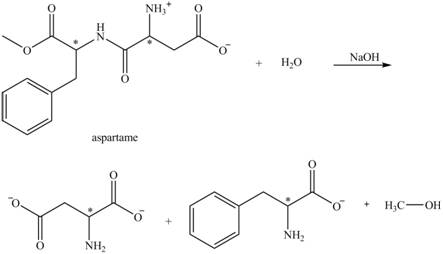
Figure 3.
The reaction of aspartame with aqueous
Want to see more full solutions like this?
Chapter 18 Solutions
Introduction to General, Organic and Biochemistry
- Given Kp for 2 reactions. Find the Kp for the following reaction: BrCl(g)+ 1/2 I2(g) ->IBr(g) + 1/2 Cl2(g)arrow_forwardFor a certain gas-phase reaction at constant pressure, the equilibrium constant Kp is observed to double when the temperature increases from 300 K to 400 K. Calculate the enthalpy change of the reaction, Ah, using this information.arrow_forwardHydrogen bonding in water plays a key role in its physical properties. Assume that the energy required to break a hydrogen bond is approximately 8 kJ/mol. Consider a simplified two-state model where a "formed" hydrogen bond is in the ground state and a "broken" bond is in the excited state. Using this model: • Calculate the fraction of broken hydrogen bonds at T = 300 K, and also at T = 273 K and T = 373 K. • At what temperature would approximately 50% of the hydrogen bonds be broken? • What does your result imply about the accuracy or limitations of the two-state model in describing hydrogen bonding in water? Finally, applying your understanding: • Would you expect it to be easier or harder to vaporize water at higher temperatures? Why? If you were to hang wet laundry outside, would it dry more quickly on a warm summer day or on a cold winter day, assuming humidity is constant?arrow_forward
- (3 pts) Use the Kapustinskii equation to calculate the lattice enthalpy for MgBr2 anddiscuss any differences between this result and that from #4.arrow_forward(3 pts) Silver metal adopts a fcc unit cell structure and has an atomic radius of 144 pm. Fromthis information, calculate the density of silver. Show all work.arrow_forward4. (3 pts) From the information below, determine the lattice enthalpy for MgBr2. Show all work. AH/(kJ mol-¹) Sublimation of Mg(s) +148 lonization of Mg(g) +2187 to Mg2+(g) Vaporization of Br₂(1) +31 Dissociation of Br,(g) +193 Electron gain by Br(g) -331 Formation of MgBr₂(s) -524arrow_forward
- 1. (4 pts-2 pts each part) Consider the crystal structures of NaCl, ZnS, and CsCl (not necessarily shown in this order). a. For one of the three compounds, justify that the unit cell is consistent with stoichiometry of the compound. b. In each of the crystal structures, the cations reside in certain holes in the anions' packing structures. For each compound, what type of holes are occupied by the cations and explain why those particular types of holes are preferred.arrow_forward(2 pts) What do you expect to happen in a Na2O crystal if a Cl− ion replaces one of the O2−ions in the lattice?arrow_forward(2 pts) WSe2 is an ionic compound semiconductor that can be made to be p-type or n-type.What must happen to the chemical composition for it to be p-type? What must happen tothe chemical composition for it to be n-type?arrow_forward
- 8. (2 pts) Silicon semiconductors have a bandgap of 1.11 eV. What is the longest photon wavelength that can promote an electron from the valence band to the conduction band in a silicon-based photovoltaic solar cell? Show all work. E = hv = hc/λ h = 6.626 x 10-34 Js c = 3.00 x 108 m/s 1 eV 1.602 x 10-19 Jarrow_forwardA solution containing 100.0 mL of 0.155 M EDTA buffered to pH 10.00 was titrated with 100.0 mL of 0.0152 M Hg(ClO4)2 in a cell: calomel electrode (saturated)//titration solution/Hg(l) Given the formation constant of Hg(EDTA)2-, logKf= 21.5, and alphaY4-=0.30, find out the cell voltage E. Hg2+(aq) + 2e- = Hg(l) E0= 0.852 V E' (calomel electrode, saturated KCl) = 0.241 Varrow_forwardFrom the following reduction potentials I2 (s) + 2e- = 2I- (aq) E0= 0.535 V I2 (aq) + 2e- = 2I- (aq) E0= 0.620 V I3- (aq) + 2e- = 3I- (aq) E0= 0.535 V a) Calculate the equilibrium constant for I2 (aq) + I- (aq) = I3- (aq). b) Calculate the equilibrium constant for I2 (s) + I- (aq) = I3- (aq). c) Calculate the solubility of I2 (s) in water.arrow_forward
 Organic ChemistryChemistryISBN:9781305580350Author:William H. Brown, Brent L. Iverson, Eric Anslyn, Christopher S. FootePublisher:Cengage Learning
Organic ChemistryChemistryISBN:9781305580350Author:William H. Brown, Brent L. Iverson, Eric Anslyn, Christopher S. FootePublisher:Cengage Learning Chemistry: Principles and PracticeChemistryISBN:9780534420123Author:Daniel L. Reger, Scott R. Goode, David W. Ball, Edward MercerPublisher:Cengage LearningChemistry: Matter and ChangeChemistryISBN:9780078746376Author:Dinah Zike, Laurel Dingrando, Nicholas Hainen, Cheryl WistromPublisher:Glencoe/McGraw-Hill School Pub Co
Chemistry: Principles and PracticeChemistryISBN:9780534420123Author:Daniel L. Reger, Scott R. Goode, David W. Ball, Edward MercerPublisher:Cengage LearningChemistry: Matter and ChangeChemistryISBN:9780078746376Author:Dinah Zike, Laurel Dingrando, Nicholas Hainen, Cheryl WistromPublisher:Glencoe/McGraw-Hill School Pub Co


